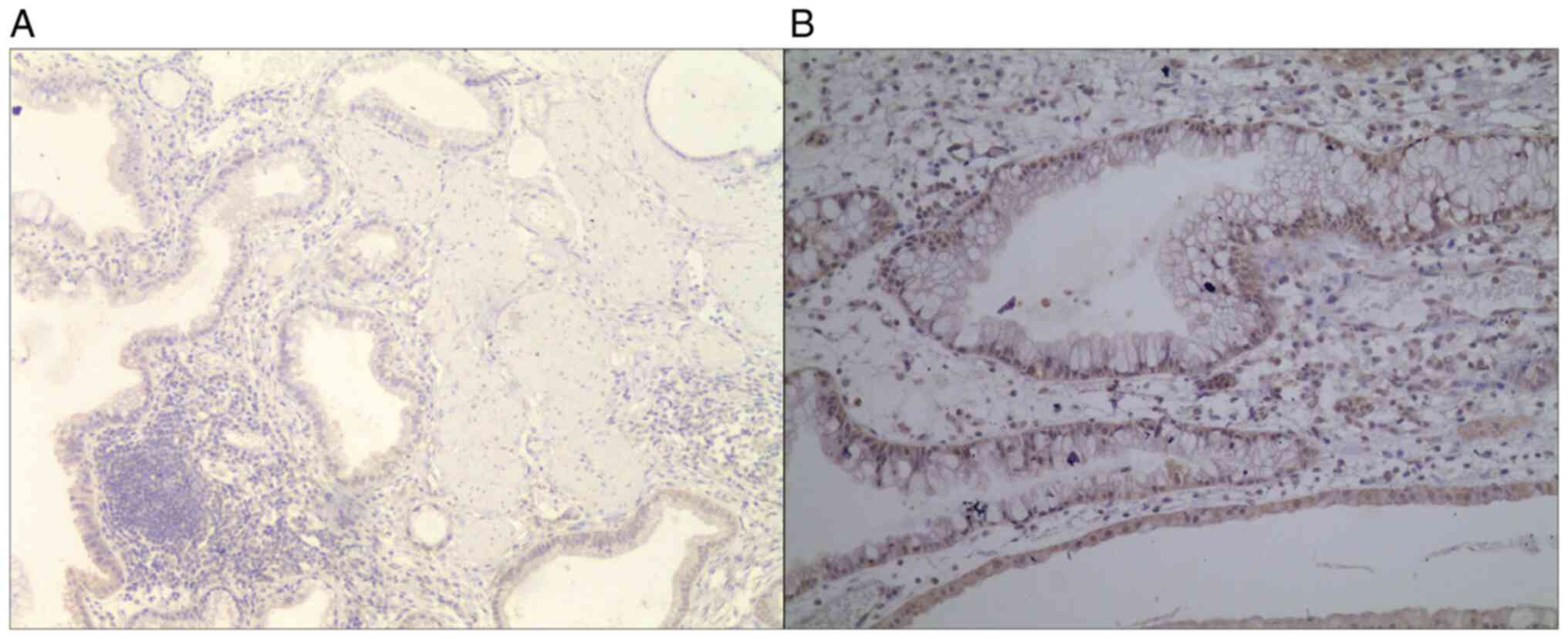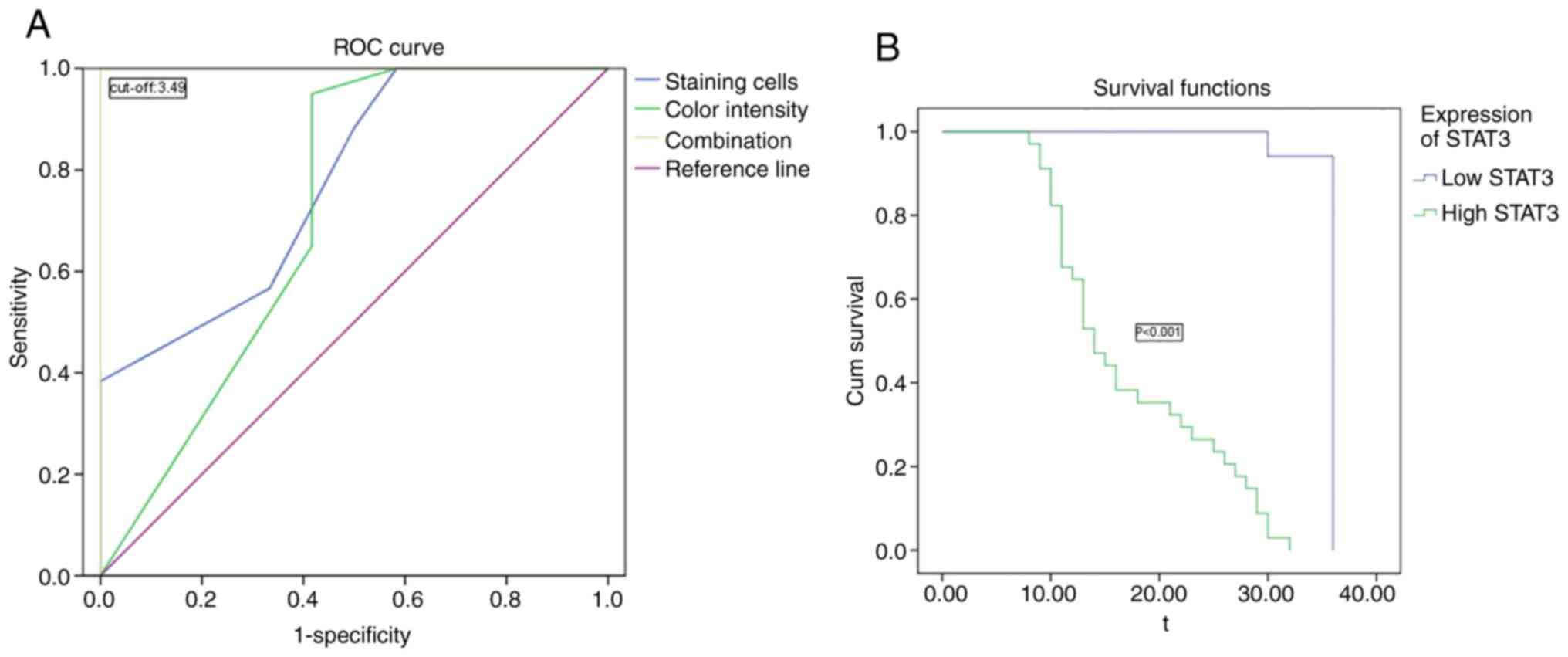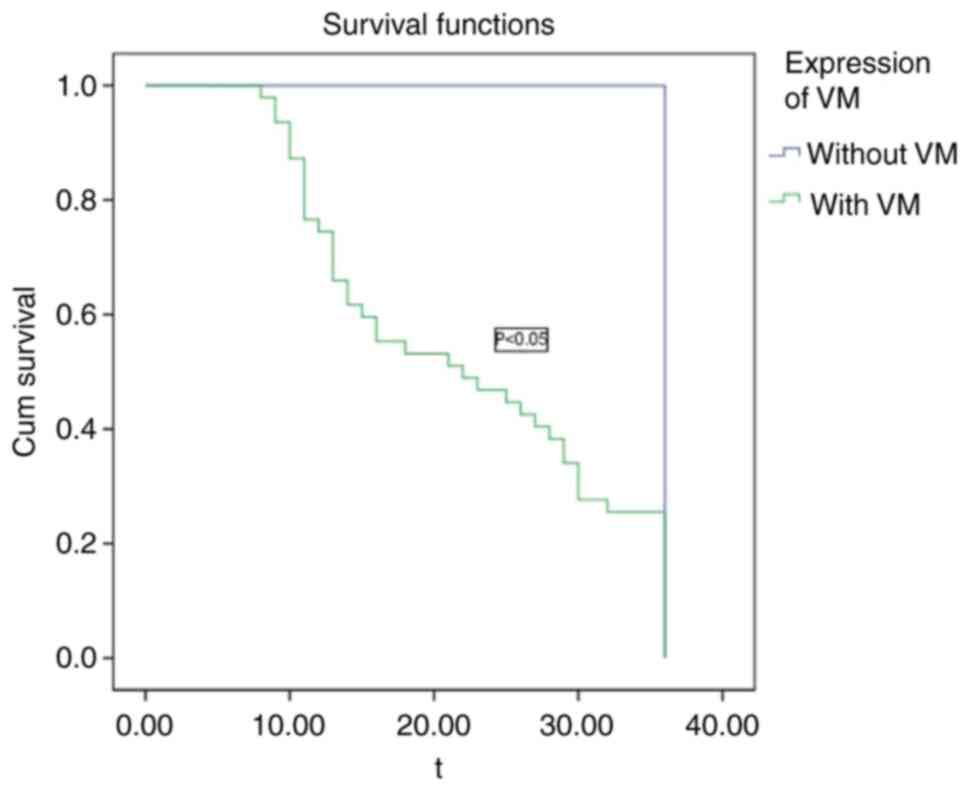|
1
|
Hundal R and Shaffer EA: Galltesticles
Cancer: Epidemiology and outcome. Clin Epidemiol. 6:99–109.
2014.
|
|
2
|
Chen W, Zheng R, Baade PD, Zhang S, Zeng
H, Bray F, Jemal A, Yu XQ and He J: Cancer statistics in China,
2015. CA Cancer J Clin. 66:115–132. 2016.PubMed/NCBI View Article : Google Scholar
|
|
3
|
Liu S, Wang X and Liu Y: Advances in
comprehensive treatment of gallbladder cancer. Surgery Concepts
& Practice. 21:365–368. 2016.
|
|
4
|
Folkman J: Tumor angiogenesis: Therapeutic
implications. N Engl J Med. 285:1182–1186. 1971.PubMed/NCBI View Article : Google Scholar
|
|
5
|
Niu G, Wright KL, Huang M, Song L, Haura
E, Turkson J, Zhang S, Wang T, Sinibaldi D, Coppola D, et al:
Constitutive Stat3 activity up-regulates VEGF expression and tumor
angiogenesis. Oncogene. 21:2000–2008. 2002.PubMed/NCBI View Article : Google Scholar
|
|
6
|
Lee SE, Jang JY, Lim CS, Kang MJ and Kim
SW: Systematic review on the surgical treatment for T1 gallbladder
cancer. World J Gastroenterol. 17:174–180. 2011.PubMed/NCBI View Article : Google Scholar
|
|
7
|
Isambert M, Leux C, Métairie S and Paineau
J: Incidentally-discovered gallbladder cancer: When, why and which
reoperation. J Visc Surg. 148:e77–e84. 2011.PubMed/NCBI View Article : Google Scholar
|
|
8
|
Cavallaro A, Piccolo G, Panebianco V, Lo
Menzo E, Berretta M, Zanghì A, Di Vita M and Cappellani A:
Incidental gallbladder cancer during laparoscopic cholecystectomy:
Managing an unexpected finding. World J Gastroenterol.
18:4019–4027. 2012.PubMed/NCBI View Article : Google Scholar
|
|
9
|
Horiguchi A, Miyakawa S, Ishihara S,
Miyazaki M, Ohtsuka M, Shimizu H, Sano K, Miura F, Ohta T, Kayahara
M, et al: Gallbladder bed resection or hepatectomy of segments 4a
and 5 for pT2 gallbladder carcinoma: Analysis of Japanese
registration cases by the study group for biliary surgery of the
Japanese Society of Hepato-Biliary-Pancreatic Surgery. J
Hepatobiliary Pancreat Sci. 20:518–524. 2013.PubMed/NCBI View Article : Google Scholar
|
|
10
|
Fathi N, Rashidi G, Khodadadi A, Shahi S
and Sharifi S: STAT3 and apoptosis challenges in cancer. Int J Biol
Macromol. 117:993–1001. 2018.PubMed/NCBI View Article : Google Scholar
|
|
11
|
Kitamura H, Ohno Y, Toyoshima Y, Ohtake J,
Homma S, Kawamura H, Takahashi N and Taketomi A:
Interleukin-6/STAT3 signaling as a promising target to improve the
efficacy of cancer immunotherapy. Cancer Sci. 108:1947–1952.
2017.PubMed/NCBI View Article : Google Scholar
|
|
12
|
Nagakura S, Shirai Y, Yokoyama N and
Hatakeyama K: Clinical significance of lymph node micrometastasis
in gallbladder carcinoma. Surgery. 129:704–713. 2001.PubMed/NCBI View Article : Google Scholar
|
|
13
|
Wang H, Zhan M, Liu Q and Wang J:
Glycochenodeoxycholate promotes the metastasis of gallbladder
cancer cells by inducing epithelial to mesenchymal transition via
activation of SOCS3/JAK2/STAT3 signaling pathway. J Cell Physiol.
235:1615–1623. 2020.PubMed/NCBI View Article : Google Scholar
|
|
14
|
Fernandez-Cortes M, Delgado-Bellido D and
Oliver FJ: Vasculogenic mimicry: Become an endothelial cell ‘but
not so much’. Front Oncol. 9:803–809. 2019.PubMed/NCBI View Article : Google Scholar
|
|
15
|
Kim SH, Lee HS, Kang BJ, Song BJ, Kim HB,
Lee H, Jin MS and Lee A: Dynamic contrast-enhanced MRI perfusion
parameters as imaging biomarkers of angiogenesis. PLoS One.
11(E0168632)2016.PubMed/NCBI View Article : Google Scholar
|
|
16
|
Dutta S, Going JJ, Crumley AB, Mohammed Z,
Orange C, Edwards J, Fullarton GM, Horgan PG and McMillan DC: The
relationship between tumour necrosis, tumour proliferation, local
and systemic inflammation, microvessel density and survival in
patients undergoing potentially curative resection of oesophageal
adenocarcinoma. Brit J Cancer. 106:702–710. 2012.PubMed/NCBI View Article : Google Scholar
|
|
17
|
Lazcano-Ponce EC, Miquel JF, Muñoz N,
Herrero R, Ferrecio C, Wistuba II, Alonso de Ruiz P, Aristi Urista
G and Nervi F: Epidemiology and molecular pathology of gallbladder
cancer. CA Cancer J Clin. 51:349–364. 2001.PubMed/NCBI View Article : Google Scholar
|
|
18
|
Lesina M, Kurkowski MU, Ludes K, Rose-John
S, Treiber M, Klöppel G, Yoshimura A, Reindl W, Sipos B, Akira S,
et al: Stat3/Socs3 activation by IL-6 transsignaling promotes
progression of pancreatic intraepithelial neoplasia and development
of pancreatic cancer. Cancer Cell. 19:456–69. 201l.PubMed/NCBI View Article : Google Scholar
|
|
19
|
Edge S, Byrd DR, Compton CC, Fritz AG,
Greene F and Trotti A (eds): AJCC Cancer Staging Manual. 7th
edition, Springer, New York, 2010. https://www.springer.com/us/book/9780387884424.
|
|
20
|
Maniotis AJ, Folberg R, Hess A, Seftor EA,
Gardner LM, Pe'er J, Trent JM, Meltzer PS and Hendrix MJ: Vascular
channel formation by human melanoma cells in vivo and in vitro:
Vasculogenic mimicry. Am J Pathol. 155:739–752. 1999.PubMed/NCBI View Article : Google Scholar
|
|
21
|
Okayasu I and Hara A: Cyclooxygenase-2 and
inducible nitric oxide synthase expression in human astrocytic
gliomas: Correlation with angiogenesis and prognostic significance.
Acta Neuropathol. 108:43–48. 2004.PubMed/NCBI View Article : Google Scholar
|
|
22
|
Li C, Chen J and Qin G: Partial Youden
index and its inferences. J Biopharm Stat. 29:385–399.
2019.PubMed/NCBI View Article : Google Scholar
|
|
23
|
Lee SE, Jang JY, Lim CS, Kang MJ and Kim
SW: Systematic review on the surgical treatment for T1 gallbladder
cancer. World J Gastroenterol. 17:174–180. 2011.PubMed/NCBI View Article : Google Scholar
|
|
24
|
Fratto ME, Santini D, Vincenzi B,
Silvestris N, Azzariti A, Tommasi S, Zoccoli A, Galluzzo S, Maiello
E, Colucci G and Tonini G: Targeting EGFR in bilio-pancreatic and
liver carcinoma. Front Biosci (Schol Ed). 3:16–22. 2011.PubMed/NCBI View
Article : Google Scholar
|
|
25
|
Chen Y, Jiang L, She F, Tang N, Wang X, Li
X, Han S and Zhu J: Vascular endothelial growth factor-C, promotes
the growth and invasion of gallbladder cancer via an autocrine
mechanism. Mol Cell Biochem. 345:77–89. 2010.PubMed/NCBI View Article : Google Scholar
|
|
26
|
Lirdprapamongkol K, Sakurai H, Abdelhamed
S, Yokoyama S, Athikomkulchai S, Viriyaroj A, Awale S, Ruchirawat
S, Svasti J and Saiki I: Chrysin overcomes TRAIL resistance of
cancer cells through Mcl-1 downregulation by inhibiting STAT3
phosphorylation. Int J Oncol. 43:329–337. 2013.PubMed/NCBI View Article : Google Scholar
|
|
27
|
Wu YS, Chung I, Wong WF, Masamune A, Sim
MS and Looi CY: Paracrine IL-6 signaling mediates the effects of
pancreatic stellate cells on epithelial-mesenchymal transition via
Stat3/Nrf2 pathway in pancreatic cancer cells. Biochim Biophys Acta
Gen Subj. 1861:296–306. 2017.PubMed/NCBI View Article : Google Scholar
|
|
28
|
O'Sullivan T, Saddawi-Konefka R, Vermi W,
Koebel CM, Arthur C, White JM, Uppaluri R, Andrews DM, Ngiow SF,
Teng MW, et al: Cancer immunoediting by the innate immune system in
the absence of adaptive immunity. J Exp Med. 209:1869–1882.
2012.PubMed/NCBI View Article : Google Scholar
|
|
29
|
Zhang Y, Guo S, Fang J, Peng B, Zhang Y
and Cao T: Tanshinone IIA inhibits cell proliferation and tumor
growth by downregulating STAT3 in human gastric cancer. Exp Ther
Med. 16:2931–2937. 2018.PubMed/NCBI View Article : Google Scholar
|
|
30
|
Ke F, Wang Z, Song X, Ma Q, Hu Y, Jiang L,
Zhang Y, Liu Y, Zhang Y and Gong W: Cryptotanshinone induces cell
cycle arrest and apoptosis through the JAK2/STAT3 and PI3K/Akt/NFκB
pathways in cholangiocarcinoma cells. Drug Des Devel Ther.
11:1753–1766. 2017.PubMed/NCBI View Article : Google Scholar
|
|
31
|
Ruiz P and Günthert U: The cellular basis
of metastasis. World J Urol. 14:141–150. 1996.PubMed/NCBI View Article : Google Scholar
|
|
32
|
Sohn EJ, Jung DB, Lee H, Han I, Lee J, Lee
H and Kim SH: CNOT2 promotes proliferation and angiogenesis via
VEGF signaling in MDA-MB-231 breast cancer cells. Cancer Lett.
412:88–98. 2018.PubMed/NCBI View Article : Google Scholar
|
|
33
|
Chen Z and Han ZC: STAT3: A critical
transcription activator in angiogenesis. Med Res Rev. 28:185–200.
2008.PubMed/NCBI View Article : Google Scholar
|
|
34
|
Okazaki H, Tokumaru S, Hanakawa Y,
Shiraishi K, Shirakata Y, Dai X, Yang L, Tohyama M, Hashimoto K and
Sayama K: Nuclear translocation of phosphorylated STAT3 regulates
VEGF-A-induced lymphatic endothelial cell migration and tube
formation. Biochem Biophys Res Commun. 412:441–445. 2011.PubMed/NCBI View Article : Google Scholar
|
|
35
|
Wang Y, Shen Y, Wang S, Shen Q and Zhou X:
The role of STAT3 in leading the crosstalk between human cancers
and the immune system. Cancer Lett. 415:117–128. 2018.PubMed/NCBI View Article : Google Scholar
|
|
36
|
Bao W, Wang HH, Tian FJ, He XY, Qiu MT,
Wang JY, Zhang HJ, Wang LH and Wan XP: A TrkB-STAT3-miR-204-5p
regulatory circuitry controls proliferation and invasion of
endometrial carcinoma cells. Mol Cancer. 12(155)2013.PubMed/NCBI View Article : Google Scholar
|
|
37
|
Kruczyk M, Przanowski P, Dabrowski M,
Swiatek-Machado K, Mieczkowski J, Wallerman O, Ronowicz A,
Piotrowski A, Wadelius C, Kaminska B and Komorowski J: Integration
of genome-wide of Stat3 binding and epigenetic modification mapping
with transcriptome reveals novel Stat3 target genes in glioma
cells. Biochim Biophys Acta. 1839:1341–1350. 2014.PubMed/NCBI View Article : Google Scholar
|
|
38
|
Cheng GZ, Zhang WZ, Sun M, Wang Q, Coppola
D, Mansour M, Xu LM, Costanzo C, Cheng JQ and Wang LH: Twist is
transcriptionally induced by activation of STAT3 and mediates STAT3
oncogenic function. J Biol Chem. 283:14665–14673. 2008.PubMed/NCBI View Article : Google Scholar
|
|
39
|
Cao C, Zhao G, Yu W, Xie X, Wang W, Yang
R, Lv X and Liu D: Activation of STAT3 stimulates AHSP expression
in K562 cells. Sci China Life Sci. 57:488–494. 2014.PubMed/NCBI View Article : Google Scholar
|
|
40
|
Enyu L, Na W, Chuanzong Z, Ben W, Xiaojuan
W, Yan W, Zequn L, Jianguo H, Jiayong W, Benjia L, et al: The
clinical significance and underlying correlation of pStat-3 and
integrin αvβ6 expression in gallbladder cancer. Oncotarget.
8:19467–19477. 2017.PubMed/NCBI View Article : Google Scholar
|
|
41
|
Sun B, Zhang D, Zhao N and Zhao X:
Epithelial-to-endothelial transition and cancer stem cells: Two
cornerstones of vasculogenic mimicry in malignant tumors.
Oncotarget. 8:30502–30510. 2017.PubMed/NCBI View Article : Google Scholar
|
|
42
|
Vartanian A, Karshieva S, Dombrovsky V and
Belyavsky A: Melanoma educates mesenchymal stromal cells towards
vasculogenic mimicry. Oncol Lett. 11:4264–4268. 2016.PubMed/NCBI View Article : Google Scholar
|
|
43
|
Pereira JA, Bilhim T, Rio Tinto H,
Fernandes L, Martins Pisco J and Goyri-O'Neill J: Radiologic
anatomy of arteriogenic erectile dysfunction: A systematized
approach. Acta Med Port. 26:219–225. 2013.PubMed/NCBI
|
|
44
|
Bissell MJ: Tumor plasticity allows
vasculogenic mimicry, a novel form of angiogenic switch. A rose by
anyother name? Am J Pathol. 155:675–679. 1999.PubMed/NCBI View Article : Google Scholar
|
|
45
|
Wang HF, Wang SS, Zheng M, Dai LL, Wang K,
Gao XL, Cao MX, Yu XH, Pang X, Zhang M, et al: Hypoxia promotes
vasculogenic mimicry formation by vascular endothelial growth
factor A mediating epithelial-mesenchymal transition in salivary
adenoid cystic carcinoma. Cell Prolif. 52(e12600)2019.PubMed/NCBI View Article : Google Scholar
|
|
46
|
Li S, Meng W, Guan Z, Guo Y and Han X: The
hypoxia-related signaling pathways of vasculogenic mimicryin tumor
treatment. Biomed Pharmacother. 80:127–135. 2016.PubMed/NCBI View Article : Google Scholar
|
|
47
|
Liu K, Sun B, Zhao X, Wang X, Li Y, Qiu Z,
Liu T, Gu Q, Dong X, Zhang Y, et al: Hypoxia promotes vasculogenic
mimicry formation by the Twist1-Bmi1 connection in hepatocellular
carcinoma. Int J Mol Med. 36:783–791. 2015.PubMed/NCBI View Article : Google Scholar
|
|
48
|
Sun H, Zhang D, Yao Z, Lin X, Liu J, Gu Q,
Dong X, Liu F, Wang Y, Yao N, et al: Anti-angiogenic treatment
promotes triple-negative breast cancer invasion via vasculogenic
mimicry. Cancer Biol Ther. 18:205–213. 2017.PubMed/NCBI View Article : Google Scholar
|
|
49
|
Hendrix MJ, Seflor EA, Seflor RE, Chao JT,
Chien DS and Chu YW: Tumor cell vascular mimicry: Novel targeting
opportunity in melanoma. Pharmacol Ther. 159:83–92. 2016.PubMed/NCBI View Article : Google Scholar
|
|
50
|
Huang B, Xiao E and Huang M: MEK/ERK
pathway is positively involved in hypoxia-induced vasculogenic
mimicry formation in hepatocellular carcinoma which is regulated
negatively by protein kinase A. Med Oncol. 32(408)2015.PubMed/NCBI View Article : Google Scholar
|
|
51
|
Vacca A, Ria R, Reale A and Ribatti D:
Angiogenesis in multiple myeloma. Chem Immunol Allergy. 99:180–196.
2014.PubMed/NCBI View Article : Google Scholar
|



















